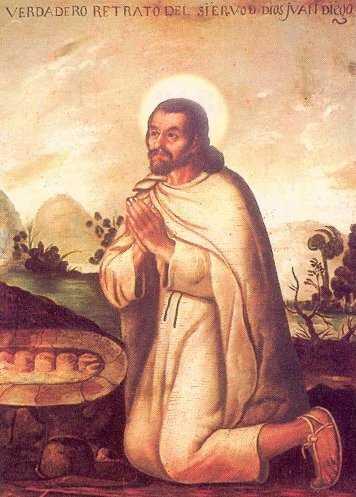Saturday of the 1st week of Advent
or Saint Juan Diego Cuauhtlatoatzin
About Today
Year: B(II). Psalm week: 1. Liturgical Colour: Violet.
Saint Juan Diego Cuauhtlatoatzin (1474 - 1548)
— A painting by Miguel Cabrera (1695 - 1768).
He was born in about 1474 in Cuauhtitlan in the kingdom of Texcoco, part of present-day Mexico. As an adult he embraced Christianity and he and his wife were baptized. In 1531 the Mother of God appeared to him, on the hill called Tepeyac near Mexico City, and told him to ask the bishop to have a church built on the spot. Through the purity of his faith, his humility and his fervour, a church was built, in honour of Our Lady of Guadalupe (whose feast is celebrated on 12 December). He left everything and devoted himself to the care of the sanctuary and the reception of pilgrims until his death in 1548.
________
Collect
O God, who sent your Only Begotten Son into this world
to free the human race from its ancient enslavement,
bestow on those who devoutly await him
the grace of your compassion from on high,
that we may attain the prize of true freedom.
Through our Lord Jesus Christ, your Son,
who lives and reigns with you in the unity of the Holy Spirit,
God, for ever and ever.
Amen.
________
About the author of the Second Reading in today's Office of Readings:
Second Reading: St Cyprian (210 - 258)
Cyprian was born in Carthage and spent most of his life in the practice of the law. He was converted to Christianity, and was made bishop of Carthage in 249. He steered the church through troubled times, including the persecution of the emperor Decius, when he went into hiding so as to be able to continue looking after the church. In 258 the persecution of the emperor Valerian began. Cyprian was first exiled and then, on the 14th of September, executed, after a trial notable for the calm and courtesy shown by both sides.
Cyprian’s many letters and treatises shed much light on a formative period in the Church’s history, and are valuable both for their doctrine and for the picture they paint of a group of people in constant peril of their lives but still determined to keep the faith.
________
Liturgical colour: violet
Violet is a dark colour, ‘the gloomy cast of the mortified, denoting affliction and melancholy’. Liturgically, it is the colour of Advent and Lent, the seasons of penance and preparation.
Liturgical colour: white
White is the colour of heaven. Liturgically, it is used to celebrate feasts of the Lord; Christmas and Easter, the great seasons of the Lord; and the saints. Not that you will always see white in church, because if something more splendid, such as gold, is available, that can and should be used instead. We are, after all, celebrating.
In the earliest centuries all vestments were white – the white of baptismal purity and of the robes worn by the armies of the redeemed in the Apocalypse, washed white in the blood of the Lamb. As the Church grew secure enough to be able to plan her liturgy, she began to use colour so that our sense of sight could deepen our experience of the mysteries of salvation, just as incense recruits our sense of smell and music that of hearing. Over the centuries various schemes of colour for feasts and seasons were worked out, and it is only as late as the 19th century that they were harmonized into their present form.

